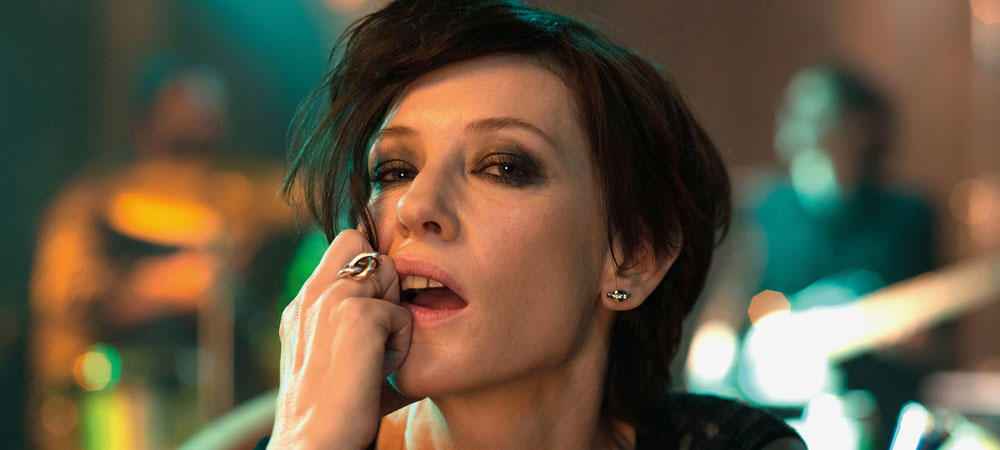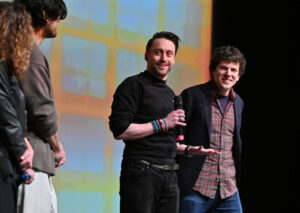Sundance.org is dispatching its writers to daily screenings and events to capture the 10 days of festivities during the Sundance Film Festival in Park City, Utah. Check back each morning for roundups from the previous day’s events.
Manifesto
by Eric Hynes
In her latest film, Cate Blanchett plays a choreographer. And also a puppeteer. And also a schoolteacher, a scientist, a newscaster, a punk rocker, a day trader — and shall we go on? Julian Rosefeldt’s Manifesto demands 13 different parts from virtuoso Blanchett, who takes on different accents, costumes, and makeup for each. It’s a remarkable feat of acting, but equally remarkable is the text that she’s serving. Each of the 13 characters represents and recites a distinct and canny collage of 20th-century art manifestos, from pop art to Fluxus, Dadaism to film, and each episode is set against a unique and provocative Berlin environment. After appearing as an art installation, most recently at the Armory in New York City, Rosefeldt refashioned the project as a feature film, which debuted at the Festival on Monday afternoon at the Library Theatre.
“I didn’t cast Cate Blanchett for this project,” Rosefeldt said during the post-screening Q&A. “We ran into each other six years ago at an art opening of my work, and we started to talk. She said, ‘Why don’t we do something together?’ You can imagine my reaction. It took me another two and a half years until we finally started to talk about Manifesto. The only thing I told Cate is that she would do many characters. We bargained — she said, ‘Can we do six or seven?’ And I said, ‘Can you do twenty?’ We ended up with thirteen. We had two weeks to shoot this — it was a fantastic trip. And now I believe she could do Mike Tyson.”
Rosefeldt spoke of the verve and passion of the manifestos chosen for the script and offered up an interesting context for texts from artists and thinkers such as John Reed, Dziga Vertov, Paul Eluard, André Breton, and Lars von Trier. “I’m an artist myself, and I know that what we say, we don’t always mean it that seriously,” he said. “Keep in mind that these texts were written when the artists had hardly left their parents’ house — they were 21, 22. And at that time of your life you’re very insecure. You’re trying to tell yourself who you are and what you stand for. And because you’re insecure you shout very loudly, and with all this anger. You pretend to have a lot of security but you actually don’t.”
The director talked about the various ways in which he matched text with character and location. Sometimes it was about finding a contemporary analogue — the hyperspeed of online trading with futurism, for example. And sometimes it was pairing opposites, with a traditional nuclear family reciting Claes Oldenburg’s funny and profane “I Am for an Art …” at dinnertime prayer. “You put two elements together that aren’t necessarily friends and then you see what the chemistry does,” he said. Rosefeldt admitted that of all of the texts, he felt most closely aligned with Jim Jarmusch’s ironically titled “Golden Rules of Filmmaking.” Jarmusch’s slogan “Nothing Is Original,” as well as the notion that all art borrows from other art, is a useful guide to “the basic spirit of the entire thing,” he said of Manifesto, “and of life itself.”
The New Radical: Exploring the World of Internet Anarchists
by Eric Hynes
As could be expected, one of the most incendiary films of the Festival made for a fascinating piece of post-screening theater. U.S. Documentary Competition candidate The New Radical surveys a new generation of internet vanguards, particularly the savvy, now-28 year-old provocateur Cody Wilson, notorious for making plans for “The Liberator” 3D printable gun available for download, as well as for co-founding Dark Wallet, a bank-skirting Bitcoin app that allows users to make transactions out of sight.

After the screening, director Adam Bhala Lough was joined by co-editor Alex Lee Moyer and Cody Wilson himself, who effortlessly seized the spotlight and expounded upon views of the internet that alternated between idealistic and apocalyptic. After bizarrely fielding questions about his favorite books and recommended places to visit in the Washington, D.C., area, he was finally outright asked what he’s trying to accomplish with his government-goading libertarian initiatives.
“With 3D-printed guns, we really believe that the internet means that one day you’re going to be able to download a gun,” he said. “It was like a proof of concept. So the materials are inadequate — so what? Give us a little time. I never wanted to be just the guy that put the gun online; I just believe in this alternative method of politics.
I believe that in order to create right now we must destroy.”
Lough said it’s a question he posed many, many times throughout the making of the film. “What’s the end goal? They were never able to succinctly illustrate it for me,” he said, which he attributed to the youth of Wilson and his associates. “When we started, Cody was like 24. He’s still figuring his shit out. So to a certain degree, he created this monster, The Liberator specifically, and had to figure out along the way, what is the goal?”
Wilson was asked a series of hypothetical questions, such as his comfort with disseminating nuclear plans and making guns downloadable for children, each resulting in a kind of Socratic exchange regarding access, freedom, and inevitability.
“Isn’t it the purpose of government to protect its citizens?” one woman from the audience asked.
“I think the purpose of this government is to secure the liberties of those governed,” Wilson responded.
“That sounds the same to me,” the woman said.
“We can disagree,” he said.
“You have to stick to your principles,” Lough said. “Freedom of information, free speech, is so vital that in this case, no matter how ugly it sounds — and I don’t want my kids going onto the Internet printing guns, and I won’t let them — but I still think we need the right to be able to make those choices for ourselves. I’ll stand by that, and I stood by that in making this film.”
Rebel in the Rye: Inside the Life of J.D. Salinger
by Jeremy Kinser
The story of how mythic writer J. D. Salinger came to create The Catcher in the Rye, considered by many to be the great American novel, gets a glossy cinematic telling in Rebel in the Rye, the feature debut from Danny Strong. The director-screenwriter draws parallels between Salinger’s life and how it shaped the creation of Holden Caulfield, his iconic outspoken character who continues to cast his spell on readers to this day.
We’re introduced to Jerome David Salinger (Nicholas Hoult) as a young man at odds with his privileged life in New York City. Despite pressure from his father (Victor Garber) to go into the family business and become “the king of bacon,” his mother (Hope Davis) is more sympathetic to nurturing her son’s burgeoning writing talent. Jerry, as he’s called, enrolls in a writing program at Columbia University, where his smart mouth draws both the ire and admiration of instructor Whit Burnett (Kevin Spacey, wringing every ounce of humor, and later pathos, he can find in the character). Burnett, the editor of Story magazine, which launched many iconic 20th-century writers, becomes a mentor to Salinger and encourages him to create a novel around Holden Caulfield, a character in one of his unpublished short stories.

Before this can happen, Salinger is sent to Europe to fight during World War II. He’s deeply affect by the atrocities he witnesses there and returns to the states at the end of the war with PTSD, which makes simple social activities a challenge for the war vet. Salinger funnels all of his frustrations with life and love into the creation of Caulfield, a new protagonist for post-war America. When Catcher is published, it becomes a sensation and Salinger’s life becomes challenging.
Since Salinger became perhaps literature’s most notorious recluse, Hoult doesn’t have to compete with video memories of the author. The photogenic actor offers a compelling turn that helps anchor the movie and hold viewer interest even when the film falls prey to some biopic conventions.
During the post-screening Q&A, Hoult told the audience he didn’t know much about Salinger prior to the project. “But speaking with Danny and reading his script, I was blown away by everything he experienced and the work he created,” he shared. “Reading more about it, I was blown away by how autobiographical his work was when you line it up with his life.”
Strong said he wanted to make this film partly because he was intrigued by the fact that Salinger “created a masterpiece that changed the world” out of the most extreme trauma a person could suffer: fighting in World War II and witnessing the atrocities of the Holocaust.
If you’re a Salinger fan, take note that this film is likely as close as you’ll ever get to seeing Caulfield on screen. Salinger thought his writing was unfilmable, and he was likely correct. An early short story was turned into a teary Susan Hayward melodrama that the writer reportedly loathed.
Burning Sands: Fraternity Pledging Comes at a High Cost
by Jeremy Kinser
A group of students at a historically black university learn that pledging a fraternity comes at too high a cost in Burning Sands, from new director Gerard McMurray. With a producing credit on the 2013 Sundance Film Festival breakout Fruitvale Station, McMurray makes his feature directorial debut with a screenplay he co-wrote with Christine Berg, and he dives right into the vicious hazing rituals during the opening scenes.
At fictional Frederick Douglass University, freshman Zurich (charismatic newcomer Trevor Jackson) has the respect of his teachers, including Professor Hughes (Alfre Woodard, in basically a cameo), but his studies and his relationship with his girlfriend (Imani Hakim) take a hit after he pledges Lambda Phi. It’s the fraternity his father had sought to join as a student before dropping out before Hell Week, so Z’s determination to succeed is strong enough to endure an almost incapacitating injury and make it through Hell Week at any cost.

If you’ve seen other fraternity-set dramas, such as last year’s much more brutal Goat, you can likely guess where this will go. Still, McMurray’s direction builds sufficient tension and he injects welcome comedic relief, particularly with the introduction of female characters.
Speaking at the Q&A that followed the premiere, McMurray revealed he’d pledged a fraternity at an all-black university, and the idea for the film came because he wanted to explore the culture of HBCUs (historically black colleges and universities) and the various subcultures within that world.
Rap artist Common, who has a producing credit on the film, was effusive in praising McMurray. “Gerard showed the diversity of who we are as black people, because each character represented different things,” he said, adding, “that brotherhood is something we don’t usually see in films.”
The Force: ‘The Wire’ of Documentaries
by Dana Kendall
Inspired in part by the hit series The Wire, director Peter Nicks began a series of documentaries exploring the institutions of the city of Oakland, California, back in 2012 with The Waiting Room, which tackled the issue of health care. He brought his second film in the series to the Sundance Film Festival this year, this time covering the city’s notorious police department.
Nicks and his team followed the police department for two years beginning in 2014, getting more than 250 hours of footage to make this complex vérité documentary. When they started, the Oakland force had already been under federal oversight for more than 10 years because of abuses and misconduct, and it still hadn’t fulfilled the requirements to regain full control.
At the outset of the project, the director knew that this was a topic on many people’s minds, but he had no idea how much the issue would explode across the nation over the course of filming.
“This was a really challenging project and process for myself personally and for my team, as we were jumping into maybe one of the most divisive issues of this city in quite some time. We began the project really wanting to understand who the men and women were on the front lines of an institution that was really being called to task, and start a national conversation. But we began the project before Black Lives Matter was even a hashtag. So the ground shifted significantly as we approached the film.”

Nicks wanted to show both the officers and activists as more than simple “two-dimensional portraits without context.” The film team aimed to “[frame] the city in a new way that brings people together” instead of encouraging divisiveness.
As we watch a new chief making a commitment to true reform, the audience feels hope for change. After new disheartening scandals, we watch Mayor Libby Schaaf ruthlessly oust those who have violated the public’s trust, attempting to squash out all the misconduct. But eventually we see that the problems run deep, and they’re embedded into the super-macho culture of the profession. In fact, when the film team already had an initial cut of the film, yet another scandal broke in 2016, this time allegations of sexual misconduct with a minor, and the team had to rethink what their story was going to look like.
At a screening during the Festival, the filmmakers gave some updates on what has happened since they wrapped. Most notable was the news that Oakland had hired a new police chief, the first female chief in the history of the department. With a slew of other women leading the city — including the mayor, her chief of staff, the city administrator, and the fire chief — many are looking forward to seeing whether the deep-seated macho culture of the police department can truly be reformed.
Nicks hinted at a third film in the series, and though he didn’t give any details, he revealed that we could look forward to seeing some of the same subjects from the second installment returning to the screen.




